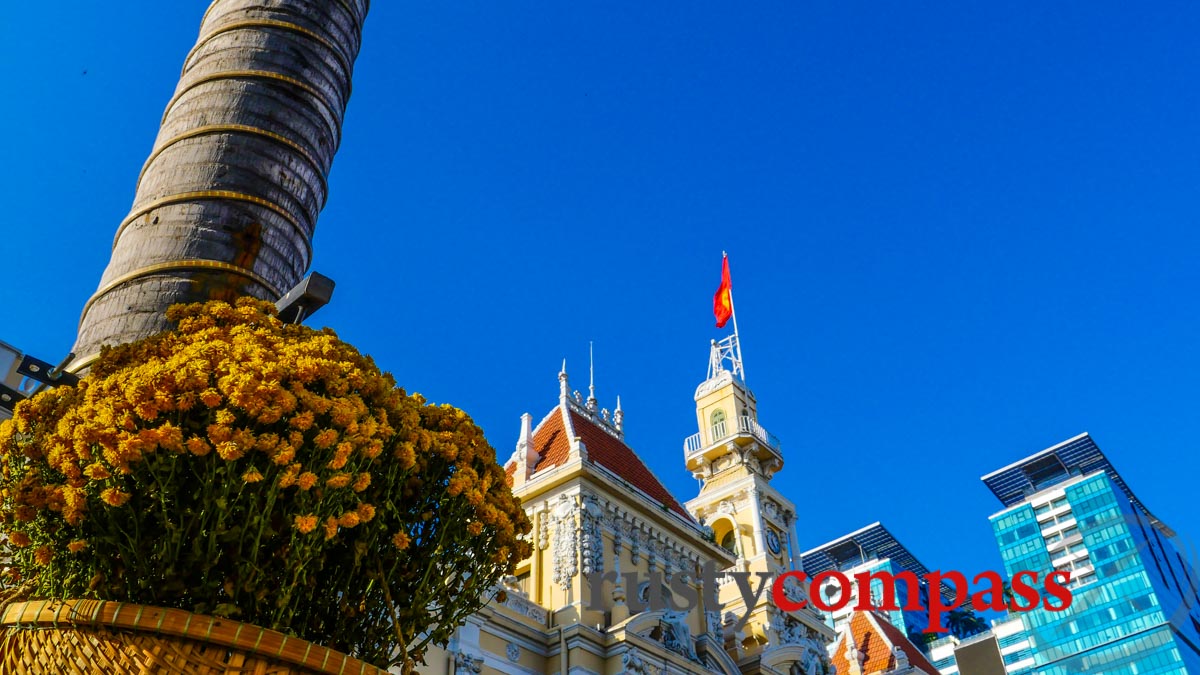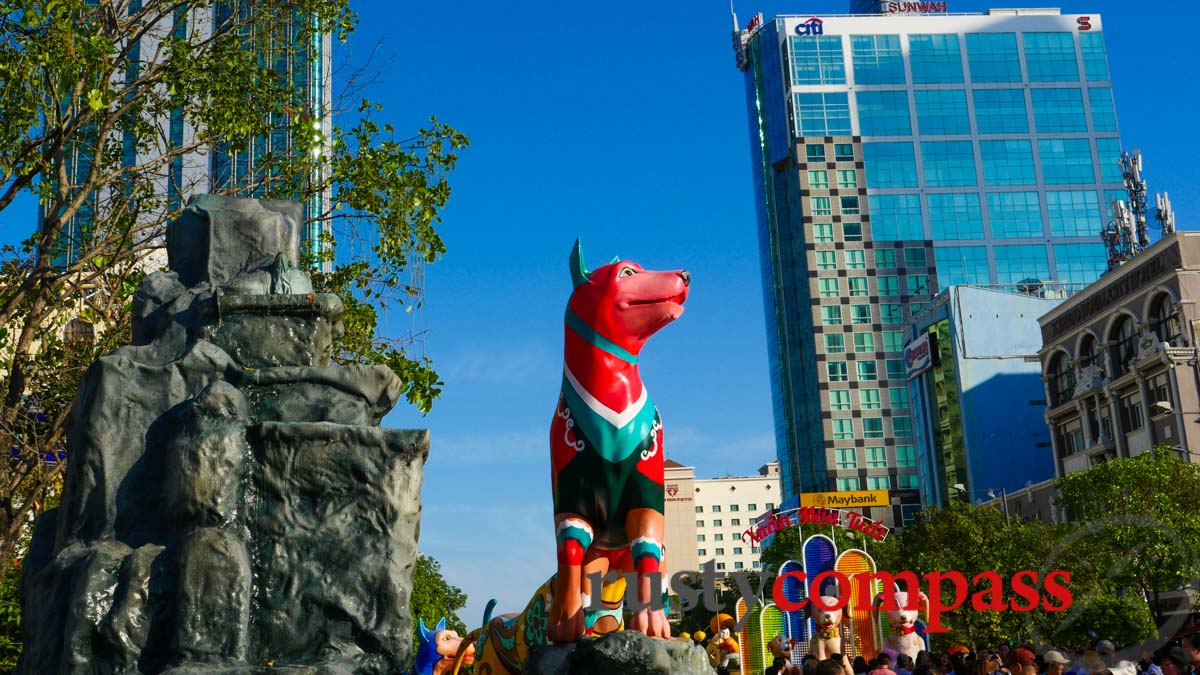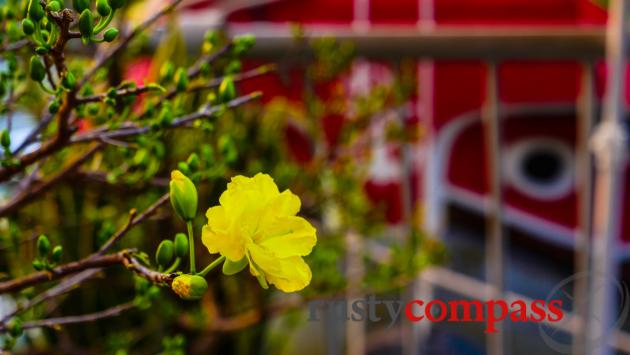Every year when the Tet Lunar New Year hits, there’s a huge movement of locals and expats out of Saigon. The locals go home to families in other cities and provinces. Foreigners head abroad. The city shuts down for a week or more.
Those who choose to stay get a sense of what Saigon felt like twenty years ago - at least in terms of congestion and air quality. Polluted skies clear. The population halves. Walking becomes possible again. It’s a different city. And it reminds me of the city I fell in love with when I first moved here in the 1990s.
Saigon has spent more than twenty years racing to develop. Incomes have risen almost ten times - a staggering accomplishment - creating a magnet for people chasing opportunity across the country. The population has almost doubled.

Photo: Mark Bowyer The clear blue skies of Saigon's Tet

Photo: Mark Bowyer Dogs like clean air too. Tet 2018
Today’s Saigonese enjoy access to wealth, goods and opportunities unimaginable a generation ago. Their city has become one of the fastest growing economic centres on the planet.
But now Saigon is suffering from the pain of all that rapid growth. When you’re travelling here, you’ll notice air pollution and traffic chaos.
Saigon’s air quality has deteriorated dramatically in recent years. Emissions from construction, cars, motorbikes and industry, have made the air toxic on many days of the year. Masks are ubiquitous.
And while traffic problems have been building for a decade, things have become dysfunctional in recent years. They seem to get worse each month. You’ll discover a city clogged with motorbikes and cars, where the bikes mount pavements at speed, with little regard for the safety of humble pedestrians.
Saigon's public transport system is woefully under-resourced for providing an attractive alternative to the motorbike and the car. Policy settings for dealing with the massive surge in car ownership seem to be too little too late.
Yet for one week, Saigon’s congestion and pollution woes melt away as half the city packs up and goes home.
All that Tet movement of people got me thinking about something else - Saigon’s huge migrant population.
Saigon has always been a city of migrants. Right from its founding in the 17th century, people have been chasing security and new opportunity here.
During the 1950s, 60s and 70s, the city’s population swelled - first with refugees from communism in the north, then those fleeing the devastation wrought by the Vietnam War.
The flight of Catholics to Saigon from the north in 1954 was so dramatic, it created a unique group in the city - known as “Bac 54” or 1954 northerners. Some Saigonese still proudly identify themselves as “bac 54” - though even their parents may have been born in Saigon.
After 1975 and the end of the Vietnam War, a new group of northerners began arriving - enabled by a newly unified Vietnam. That huge migration continues to this day. The reasons have evolved but Saigon’s draw for people from all over the country has been constant. Interestingly, there is no equivalent movement north towards the capital.
Something else started to happen in the 1960s that has proven just as consequential for the city. Educated and wealthy Vietnamese began to leave war-torn Saigon in search of peace and stability.
As the fall of Saigon neared, a steady flow turned into a torrent. It’s thought that perhaps 2 million Vietnamese fled communism and poverty in the 1970s and early 1980s. Many of them from Saigon. Many of them perished.
These days, while Saigon’s population growth gets most of the attention, there are still lots of people leaving. And while numerically smaller, these departures may be as consequential as the arrivals.
Those leaving tend to be among city’s best and brightest. The people with the skills to make a major contribution to the city’s future. They leave to contribute in the US, Singapore, Australia, Canada and elsewhere. They can be found at high levels of corporate life, government and the arts around the world.
My sense of the scale of this brain drain was heightened as I received Tet wishes from successful Vietnamese I have met over the decades. They came from across the world from a remarkably large and impressive collection of people. Unlike the boat people, many of these are the children of the revolution - the offspring of the winners of war.
It’s believed that as many of 70% of Vietnam’s current batch of international students may not return.
They add environmental concerns, specifically air quality, to their list of reasons for leaving.
These educated, professional people are essential to the next phase of Vietnam’s economic development. Their loss to the country is disastrous.
In a way, these high achievers, normally educated at their own expense, are providing a type of inverse welfare to developed countries at the expense of their places of birth.
I have often wondered how Vietnam would look if there had not been such a huge exodus over the past half-century. The US, Australia, Canada, France and other countries are richer for their large Vietnamese communities. How has that loss shaped modern Vietnam?
Barack Obama referenced the brain drain obliquely when he visited Vietnam in 2016.
He said, “No job is so important that it’s O.K. if your children have asthma and they can’t breathe.”
It’s advice that he might want to reiterate to his successor. The Trump administration is rolling back decades of environmental protection. But it also resonates in Vietnam.
As other cities and countries around the region and the world compete for talent, liveability is becoming a major issue. And air quality ranks very high as a measure of liveability.
Saigon faces two pressing challenges. It needs to continue to create a city liveable and attractive for those arriving from elsewhere in the country and the world. It also needs to be attractive enough to persuade its best and brightest to stay.





There are no comments yet.